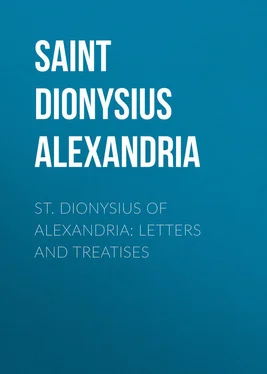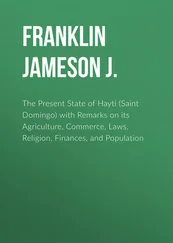Saint Dionysius of Alexandria - St. Dionysius of Alexandria - Letters and Treatises
Здесь есть возможность читать онлайн «Saint Dionysius of Alexandria - St. Dionysius of Alexandria - Letters and Treatises» — ознакомительный отрывок электронной книги совершенно бесплатно, а после прочтения отрывка купить полную версию. В некоторых случаях можно слушать аудио, скачать через торрент в формате fb2 и присутствует краткое содержание. Жанр: foreign_religion, foreign_antique, foreign_prose, на английском языке. Описание произведения, (предисловие) а так же отзывы посетителей доступны на портале библиотеки ЛибКат.
- Название:St. Dionysius of Alexandria: Letters and Treatises
- Автор:
- Жанр:
- Год:неизвестен
- ISBN:нет данных
- Рейтинг книги:5 / 5. Голосов: 1
-
Избранное:Добавить в избранное
- Отзывы:
-
Ваша оценка:
- 100
- 1
- 2
- 3
- 4
- 5
St. Dionysius of Alexandria: Letters and Treatises: краткое содержание, описание и аннотация
Предлагаем к чтению аннотацию, описание, краткое содержание или предисловие (зависит от того, что написал сам автор книги «St. Dionysius of Alexandria: Letters and Treatises»). Если вы не нашли необходимую информацию о книге — напишите в комментариях, мы постараемся отыскать её.
St. Dionysius of Alexandria: Letters and Treatises — читать онлайн ознакомительный отрывок
Ниже представлен текст книги, разбитый по страницам. Система сохранения места последней прочитанной страницы, позволяет с удобством читать онлайн бесплатно книгу «St. Dionysius of Alexandria: Letters and Treatises», без необходимости каждый раз заново искать на чём Вы остановились. Поставьте закладку, и сможете в любой момент перейти на страницу, на которой закончили чтение.
Интервал:
Закладка:
Restoration of Peace
12. The persecution lasted till the autumn of 260, and was then, on the disappearance of Valerian, stayed by an edict of Peace issued by his son Gallienus, who was now left alone upon the throne. The Greek version, which Eusebius gives us, is apparently not that of the actual edict, but of the Emperor’s letter or rescript which applied it to Egypt. It is addressed to Dionysius and other bishops, and runs as follows: “I have ordained that the benefit of my concession be enforced throughout the world, to the effect that men should withdraw from ( i. e. not interfere with) your places of worship. And accordingly ye, too, may use the terms of my rescript, so that none may interfere with you. And this, which may with authority be carried out by you, has already been granted by me some time ago. And accordingly Aurelius Quirinius, who is in charge of the Exchequer, 7 7 The office indicated seems to be the same as that of Rationalis mentioned above on p. 16 .
shall preserve this form now given by me.” Instructions were also issued permitting the Christians to have free access to their cemeteries – a privilege which was always much prized.
His Return to Alexandria
13. It is practically certain that Dionysius returned to Alexandria as soon as Gallienus’s edict came into operation there. But almost immediately fresh disturbances were felt in the city, followed by one of those frequent outbreaks of pestilence to which the East was always liable, and these hindered for a time his work of bringing the brethren together again. The disturbances are with good reason thought to have been those connected with the attempt of Macrianus to overturn the power of Gallienus in Egypt, though that country was so often the scene of tumults and civil wars for the next twelve years and more that it is almost impossible to identify any particular disturbances with certainty during this period.
The Troubles Connected with his Protest against Sabellianism
14. For another five years Dionysius was spared to administer his charge and to benefit the Church at large with his prudent counsels. But, though attacks upon himself never seem to have troubled him very much, he had still to endure one such attack which probably grieved him more than all the rest, and the after results of which lingered on till the days of Athanasius and Basil in the next century. This was in connexion with the Sabellian controversy, especially that phase of it which had recently arisen in the Libyan Pentapolis (on the north-west coast of Cyrenaica). Sabellius was a native of the district, and his heresy consisted in laying too much stress on the unity of the Godhead and in so hopelessly confounding the Three Persons in the Trinity as to imply that the Person of the Father was incarnate in Christ. It is in 257 that we first find Dionysius, in a letter to Xystus II ( see p. 55 Конец ознакомительного фрагмента. Текст предоставлен ООО «ЛитРес». Прочитайте эту книгу целиком, купив полную легальную версию на ЛитРес. Безопасно оплатить книгу можно банковской картой Visa, MasterCard, Maestro, со счета мобильного телефона, с платежного терминала, в салоне МТС или Связной, через PayPal, WebMoney, Яндекс.Деньги, QIWI Кошелек, бонусными картами или другим удобным Вам способом.
), calling the attention of the Bishop of Rome to these views, by which time Sabellius was himself probably already dead. From what he says there, it appears as if Dionysius was unaware that these views were not of quite recent origin and were already rather prevalent in both East and West, whilst his words seem also to imply that this later phase of Sabellianism endangered the dignity of the Third Person as well as of the First and Second. In Libya the heresy gained such a hold upon the Church that it even infected certain of the Bishops, and the Son of God was no longer preached. Dionysius, therefore, feeling his responsibility for the churches under his care, became active in trying to eradicate the evil. Among a number of letters which he wrote on the subject, there was one (about the year 260) in which he made use of certain expressions and illustrations with regard to the Son of God, which were seized hold of by some members of the Church either at Alexandria or in the Pentapolis as heretical. This letter was apparently one of the later letters of the series, when his earlier overtures had failed to produce the effect he desired.
15. Dionysius’s critics laid a formal complaint against him before his namesake (Dionysius), who had by now succeeded the martyred Xystus II as Bishop of Rome; they accused him of having fallen into five errors himself, while correcting the false views of the Sabellians.
They were as follows, as we gather them from Athan., de sent. Dion. : —
(1) Separating the Father and the Son.
(2) Denying the eternity of the Son.
(3) Naming the Father without the Son and the Son without the Father.
(4) Virtually rejecting the term ὁμοούσιος (of one substance) as descriptive of the Son.
(5) Speaking of the Son as a creature of the Father and using misleading illustrations of their relation to One Another.
One or two of these illustrations which were objected to will be found in the extract translated on p. 103 Конец ознакомительного фрагмента. Текст предоставлен ООО «ЛитРес». Прочитайте эту книгу целиком, купив полную легальную версию на ЛитРес. Безопасно оплатить книгу можно банковской картой Visa, MasterCard, Maestro, со счета мобильного телефона, с платежного терминала, в салоне МТС или Связной, через PayPal, WebMoney, Яндекс.Деньги, QIWI Кошелек, бонусными картами или другим удобным Вам способом.
, and they are sufficient to give some idea of the rest. It may, however, be acknowledged that neither Dionysius himself in his original statements and in his attempts to explain them, nor Athanasius, who, when Arius afterwards appealed to Dionysius in support of his opinions, put forward an elaborate defence of him, was altogether happy or successful.
16. Upon receiving the complaint mentioned, the Bishop of Rome appears to have convened a synod, which condemned the expressions complained of, and a letter was addressed by him on the modes of correcting the heresy to the Church of Alexandria. From motives of delicacy he made no actual mention of his Alexandrian brother-bishop in this letter, while criticizing his views, though he wrote to him privately asking for an explanation. A considerable portion of the public letter has been preserved for us by Athanasius, but it is not included in this volume, nor is it necessary to particularize his treatment of the question or to say more than this, that, though the Roman Bishop wrote quite good Greek and gives no impression that he felt hampered by it in expressing his meaning, yet he does naturally exhibit distinct traces of Western modes of thought as opposed to Eastern, and is not always quite fair in his representation and interpretation of what Dionysius had said.
Dionysius’s answer to his Roman brother was embodied in the treatise called Refutation and Defence (Ἔλεγχοσ καὶ Ἀπολογία), some extracts from which (as given by Athanasius) will be found on pp. 101 ff. Конец ознакомительного фрагмента. Текст предоставлен ООО «ЛитРес». Прочитайте эту книгу целиком, купив полную легальную версию на ЛитРес. Безопасно оплатить книгу можно банковской картой Visa, MasterCard, Maestro, со счета мобильного телефона, с платежного терминала, в салоне МТС или Связной, через PayPal, WebMoney, Яндекс.Деньги, QIWI Кошелек, бонусными картами или другим удобным Вам способом.
Интервал:
Закладка:
Похожие книги на «St. Dionysius of Alexandria: Letters and Treatises»
Представляем Вашему вниманию похожие книги на «St. Dionysius of Alexandria: Letters and Treatises» списком для выбора. Мы отобрали схожую по названию и смыслу литературу в надежде предоставить читателям больше вариантов отыскать новые, интересные, ещё непрочитанные произведения.
Обсуждение, отзывы о книге «St. Dionysius of Alexandria: Letters and Treatises» и просто собственные мнения читателей. Оставьте ваши комментарии, напишите, что Вы думаете о произведении, его смысле или главных героях. Укажите что конкретно понравилось, а что нет, и почему Вы так считаете.












